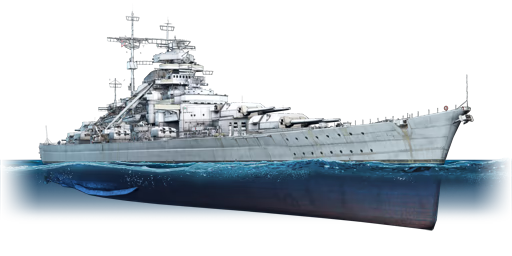The Bismarck was the lead ship of Bismarck-class battleships. Laid down on 1 July 1936 and launched on 14 February 1939, she was designed to counter the French naval expansion (and more specifically the Richelieu-class battleships). Bismarck and her sister ship Tirpitz became the largest battleships built at that time. After entering service on 24 August 1940, Bismarck was paired with the heavy cruiser Prinz Eugen to conduct convoy raids in the Atlantic Ocean.
During her short eight-month service, Bismarck would only engage in battle twice. The first was the Battle of the Denmark Strait on 24 May 1941 against the British flagship HMS Hood and battleship HMS Prince of Wales, when Bismarck managed to score an extremely lucky hit on Hood's magazine, resulting in a catastrophic explosion that destroyed Hood in just five minutes after the engagement began. Bismarck’s fuel tanks were damaged by Prince of Wales, forcing the captain to order the ship back to occupied France for repair. The loss of Hood enraged the Royal Navy to the point that they mobilized the entire Atlantic fleet to hunt Bismarck down. Just two days later on 26 May, the damaged Bismarck fought in her second and last battle. In the ensuing battle, Bismarck’s rudder was jammed by a torpedo from the antiquated Fairey Swordfish launched from HMS Ark Royal. Then, a destroyer fleet was sent to harass the ship to keep her crew occupied throughout the night. Finally, on 27 May, Bismarck was pummelled by combined fire from battleships HMS King George V and Rodney, as well as heavy cruisers HMS Dorsetshire and Norfolk. After all her guns were disabled, the severely damaged Bismarck was scuttled by the remaining German crews. Out of 2,221 crewmembers, only 114 survived the sinking.
The Bismarck was introduced in Update "Leviathans". Much like her real-life partner Prinz Eugen, Bismarck is a well-rounded ship with a main focus on her firepower. Her eight 380 mm guns feature excellent accuracy and rate of fire that allows her to accurately target the weakspots of enemy ships, though the penetration of her AP shell is on the lower side compared to her contemporaries. While her mobility and protection are good for her time, this is offset by the mediocre AA suite that is not as effective in dealing with aerial targets.














